Sheaumann’s diode laser pumped 2.94 µm Er:YAG MIR-Pac laser product1,2 can be operated in the quasi-continuous-wave (QCW) pulsed mode. This mode - also known as normal-mode or long-pulse operation - sees the laser operated with pulse durations long enough for the laser to achieve steady-state operating condition. This article outlines the key characteristics of this highly beneficial mode of operation.
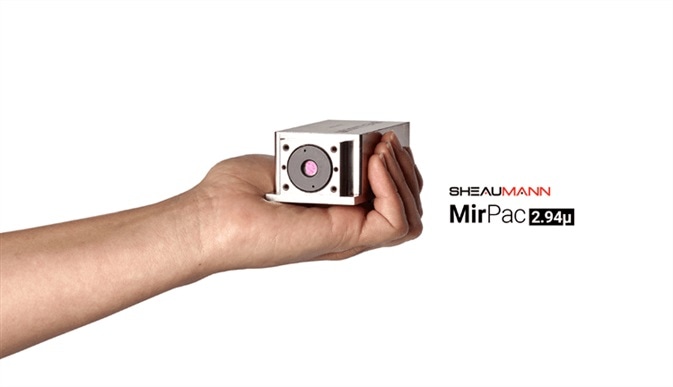
Image Credit: Sheaumann Laser, Inc.
When functioning in continuous operating mode, the MIR-Pac laser is able to operate at 0.75 W of output power in a TEM00 mode beam (M2<1.2). It also features a typical beam divergence of 17 mrad.
Despite being specified at 0.75 W of output power, the laser can typically operate at output powers on the order of 1 W (Figure 1), while offering a maximum pump laser continuous drive current rating of 6 A.

Figure 1. Output power versus drive current performance of a 2.94 μm MIR-Pac laser. Image Credit: Sheaumann Laser, Inc.
The MIR-Pac laser is optically pumped via a diode laser, and it is possible to pulse or continuously operate this diode laser using an appropriate drive current waveform. Using a rectangular current pulse to drive the diode laser with rise times <10 µs allows the corresponding optical pump pulse to efficiently generate a population inversion that exceeds the lasing threshold.
The finite build up time required to achieve the lasing threshold prompts an initial population inversion density larger than the threshold inversion density occurring by the time lasing commences. Excess gain results in the creation of a short laser pulse, depleting the population inversion. This process is repeated a number of times.
These initial laser pulses are typically understood as being ‘gain switched,’ with the generation of gain switched pulses quickly yielding to damped intensity oscillations (relaxation oscillations). These pulses stop once intensity achieves a steady-state value (Figure 2 and Figure 3).
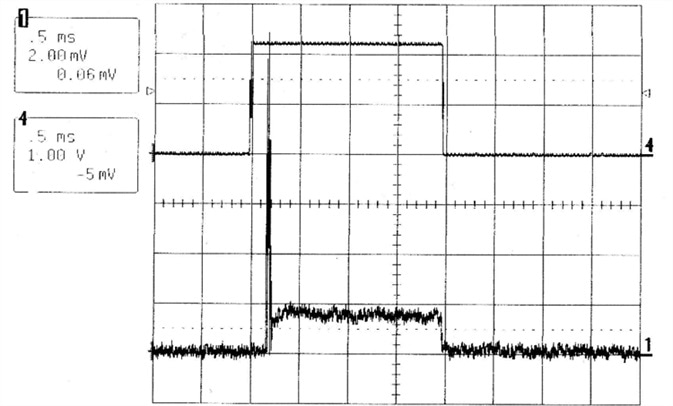
Figure 2. QCW MIR-Pac laser output (lower trace) and drive current waveform (upper trace) for a 0 A to 10 A, 2 ms duration current pulse at a 100 Hz repetition rate. Image Credit: Sheaumann Laser, Inc.
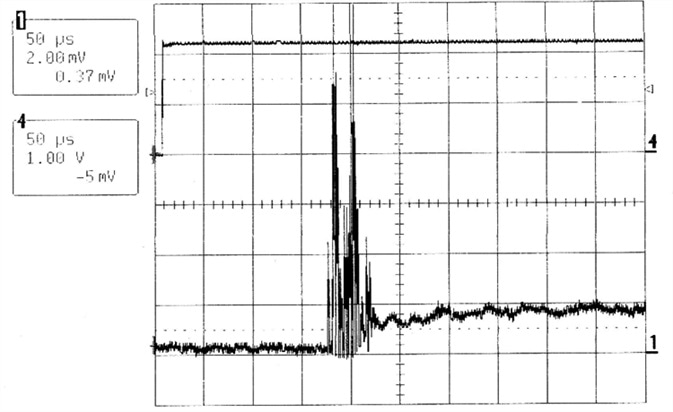
Figure 3. QCW MIR-Pac laser output (lower trace) and drive current waveform (upper trace) corresponding to the first 0.5 ms of Figure 2. Image Credit: Sheaumann Laser, Inc.
Once the optical pump pulse has been completed, the majority of lasers will switch off with a monotonic decrease in intensity. The MIR-Pac laser switches off by emitting a number of decaying relaxation oscillations, however (Figure 4).

Figure 4. QCW MIR-Pac laser output (lower trace) and drive current waveform (upper trace) showing the relaxation oscillation decay at the end of the laser pulse. Image Credit: Sheaumann Laser, Inc.
These oscillations will be of an identical type to the oscillations at the start of the QCW laser pulse. They occur due to the gain medium’s distinct pumping dynamics, Er:YAG.3,4
Figure 5 shows a series of pumping dynamics, whereby the 6.4 ms lifetime of the lower laser level (4I13/2) is much longer than the 0.1 ms lifetime of the upper laser level (4I11/2). The strong upconversion from the lower laser level depletes its population while ensuring greater than unity quantum efficiency – therefore avoiding self-saturation.
One notable downside of the upconversion process is highlighted as the laser switches off. Under these circumstances, the 4I11/2 level is populated even following termination of the pump pulse, resulting in the generation of a series of decaying relaxation oscillations; much like those occurring at the start of the laser pulse. Figure 5 shows the energy level dynamics in Er:YAG throughout this process.

Figure 5. The energy level diagram for Er:YAG showing the pump absorption and laser transitions. Upconversion from the lower laser level, 4I13/2, provides greater than unity quantum efficiency. Image Credit: Sheaumann Laser, Inc.
The relaxation oscillation damping time (τ0) of an ideal four level laser5 can be determined using the following formula.

The upper laser level’s (τ) characteristic lifetime is adjusted by the ratio of population inversion density at threshold to the total number of active ion sites in the pumped region of the gain medium (Nth Nt) alongside the number of occasions that the optical pumping rate exceeds the lasing threshold (Wp Wp,th).
It is evident that pumping harder will result in a reduction in relaxation oscillation damping time. MIR-Pac 2.94 µm Er:YAG laser exhibits this behavior despite it possessing different energy level dynamics to the ideal four level laser.
Pumping the MIR-Pac laser slightly under its lasing threshold prior to the primary pumping pulse will reduce relaxation damping time while almost entirely eliminating build up time delay (Figure 6). The optimum pulsed drive current for QCW operation of the MIR-Pac laser is comprised of a continuous bias current set to 80% of the continuous lasing threshold value (typically 2 A), and a larger pulsed drive current.

Figure 6. QCW MIR-Pac laser output (lower trace) and drive current waveform (upper trace) for a 2 A to 10 A, 2-ms duration current pulse at a 100 Hz repetition rate. Image Credit: Sheaumann Laser, Inc.
Peak drive current may reach the 15 A maximum permitted drive current of the diode pump laser, provided that the duty cycle corrected average MIR-Pac laser output power is not greater than the maximum operating power defined in the test data sheet for the device.
The MIR-Pac laser’s pulsed peak power capacity is limited by an identical thermal fracture mechanism to its capacity for continuous operation. This has been specified at 0.75 W for the current product, with maximum operating powers typically as high as 1 W (Figure 1).
The recommended peak power limit would be specified at 7.5 W for quasi-continuous operation at a duty cycle of 10% -1 ms pulses at a repetition rate of 100 Hz.
The standard MIR-Pac laser product features a pump diode laser that is limited to a maximum drive current of 15 A in practice – capabilities corresponding to peak powers around 4 W at 2.94 µm.
Figures 7 and 8 contain data that highlights the generation of up to 2.5 W peak powers in QCW operation working at a 10 A peak drive current. This process is taking place while generating millisecond regime pulses at pulse repetition rates up to 600 Hz and features corresponding pulse energies up to ~5 mJ (2 ms pulses at 200 Hz).
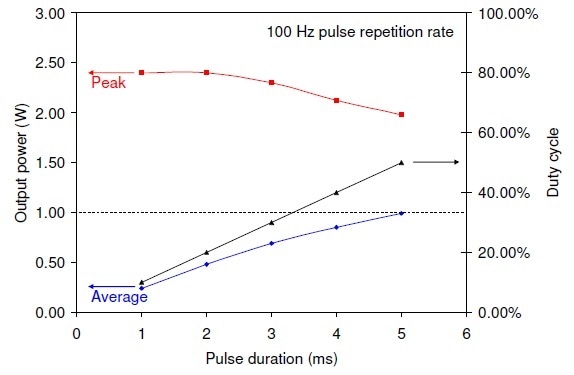
Figure 7. QCW laser performance at a fixed pulse repetition rate of 100 Hz for 8 A drive current pulses superimposed on a 2 A continuous bias current. Image Credit: Sheaumann Laser, Inc.
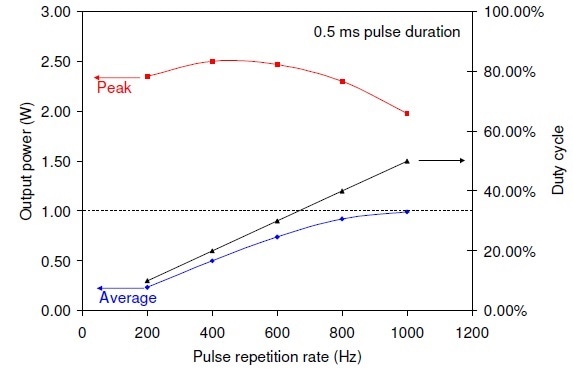
Figure 8. QCW laser performance at a fixed pulse duration of 0.5 ms for 8 A drive current pulses superimposed on a 2 A continuous bias current. Image Credit: Sheaumann Laser, Inc.
In the example presented here, the average power limit is reached only at duty cycles close to 50% and pulse peak powers close to 2 W. These examples feature corresponding pulse energies of 1 mJ at 1 kHz.
Users are advised to ensure that any electronics employed in the delivery of pulsed or continuous drive currents to the MIR-Pac laser do not feature positive or negative switching transients exceeding its internal pump diode laser’s safe operating limits. Negative voltage - continuous or pulsed – cannot safely be applied to the laser, while positive drive currents - continuous or pulsed - should never exceed 15 A.
Under QCW operation, the MIR-Pac laser experienced average heat loads that may be significantly less than those head loads experienced continuous operation. This does depend on the specific duty cycle of the pulse modulation format, however, prompting the operating wavelength of the pump diode laser to drift from the optimal pumping wavelength.
Users may be required to adjust the temperature set point of the MIR-Pac laser’s pump diode laser when working under QCW operation, in order to achieve maximum average and peak output powers for the pulse modulation format in use.
The first gain switched laser pulse found at the beginning of the relaxation oscillations can be isolated by means of a short duration pump pulse, but this method is not generally regarded as a reliable approach to generating a short duration output pulse.
Build up times of the both first gain switched laser pulse and the next pulse are considerably impacted by QCW laser performance. A fixed pulse duration of spontaneous emission conditions drive this lasing process, meaning that any timing jitter of the first and second gain switched laser pulses will be on the order of the time interval between these pulses.
These factors result in the generation of one, or sometimes even two pulses exhibiting a several hundred nanosecond timing jitter.
References
- http://www.sheaumann.com
- D. Chen et al., “Diode-pumped 1-W continuous-wave Er:YAG 3-µm laser,” Opt. Lett., 24, 385, (1999).
- R.C. Stoneman and L. Estrowitz, “Efficient resonantly pumped 2.8-µm Er3+:GSGG laser,” Opt. Lett., 17, 816, (1992).
- S. Georgescu and O. Toma, “Er:YAG three-micron laser: performances and limits,” IEEE. Sel. Top. Quant. Electron., 11, 682, (2005).
- J.J. Zayhowski, D. Welford and J. Harrison, “Miniature Solid-State Lasers,” Chapter 10, The Handbook of Photonics, second edition, CRC Press, 2007.
Acknowledgments
Produced from materials originally authored by Gary Sousa and Josh Foster from Sheaumann Laser, Inc.
About Sheaumann Laser, Inc.

Sheaumann Laser specializes in the design and manufacture of semiconductor laser diodes and modules for sensing, imaging, telecom, navigation, and illumination applications for the industrial, defense, and medical industries. We also produce space-qualified lasers for data transmission from satellites.
All of our R&D and production activities are efficiently housed in one centralized facility near Boston, giving us complete control over all processes and the flexibility to create custom solutions for OEMs with unique requirements.
Our 18,000 square foot cleanroom houses all activities, from wafer growth to test and reliability, under one roof. Our quality management system is certified to ISO 9001:2015 and CMMC readiness Level 3 for NIST SP 800-171, FAR 52.204-21 and DFARS 252.204-7012 compliance. Our products also comply with RoHS 3 and REACH requirements.
Sponsored Content Policy: News-Medical.net publishes articles and related content that may be derived from sources where we have existing commercial relationships, provided such content adds value to the core editorial ethos of News-Medical.Net which is to educate and inform site visitors interested in medical research, science, medical devices and treatments.